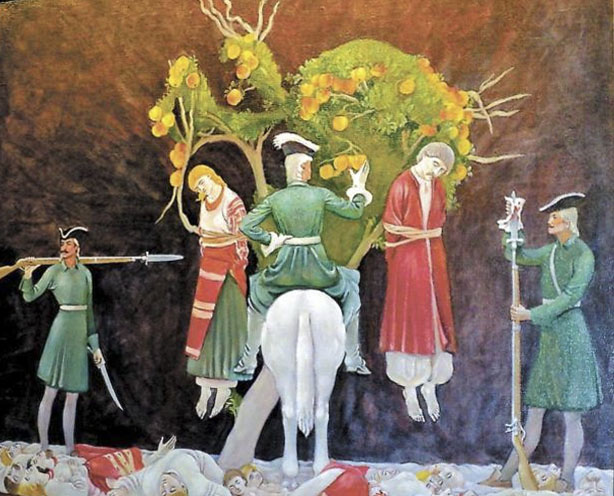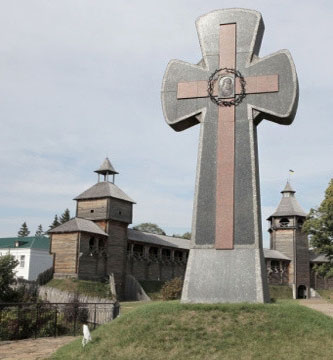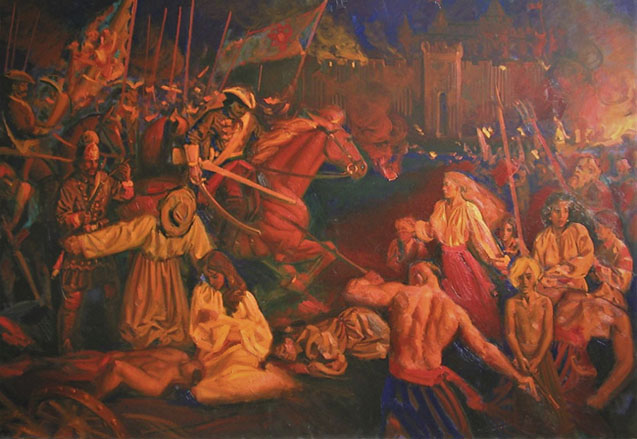Baturyn Massacre in 1708. Artist Andrii Ivachnenko, 2000 https://uk.wikipedia.org
2 November 1708 (by the old calendar or styl) became a tragedy date for Baturyn, also called Baturyn Massacre. The historians assigned this name to the Muscovite punitive expedition of capturing and destroying Baturyn, the capital city of hetman Ivan Mazepa, together with slaughtering the majority of its civilian inhabitants.
The city of Baturyn is located in Chernihivska oblast (region), 180 km from the City of Chernihiv and 220 km from Kyiv. The first mention of Baturyn dates back to 1625. This city was a considerable player in the history of Ukraine. During the periods of 1669–1708 and 1750–1764, it was the hetman capital of the Livoberezhna Ukraine (Left-Bank Ukraine). In the last quarter of the 17th century, Baturyn was a major cultural center. At the beginning of the 18th century, the Baturyn population number reached 10 000 inhabitants.
During the Great Northern War (1700–1721), hetman (leader) Ivan Mazepa decided to seize the opportunity for Ukraine to abandon the Muscovite political influence. In this decision, Ivan Mazepa was supported by the Ukrainian Cossacks with Kostia Hordiienko, the kosh otaman or chief ataman, in charge and the leading members of the Hetmanate Officer Council. After Mazepa allianced with the Swedish king Karl XII, the Muscovite Tsar Peter I ordered to punish all who had supported Mazepa and to capture Baturyn.
The city was a strong fortress equipped with 70 cannons. Marshal Aleksandr Menshikov with 20 000 Muscovite army of shooters and dragoons came to the fortress walls and demanded the capitulation. The defence was organised by Cossack colonel Dmytro Chechel. The inhabitants of Baturyn refused to capitulate while the Cossacks answered that they would rather die than give the hetman capital to the enemy.
The Muscovites were trying to seize the city during 3 days. But only after colonel Ivan Nis (Pryluky regiment) betrayed and showed the secret passageway into Baturyn were the Muscovites able to break into the city. The stiff resistance of the Cossack garrison was suppressed during 2 hours. The mass killing, as the excavations have showed, was executed near the hetman palace and the houses of the Cossack officers.
From 11 000 to 15 000 people were murdered, according to different estimations. No mercy was given to the civilians of the city and 6 000-7500 victims of the violence were women, children, or the elderly plus 6 000-6 500 military people.
Menshikov ordered to crucify the bodies of the Cossacks and to put them on the rafts to drift down the Seim River in order to show everybody in Hetmanate what was the horrible destiny of the city. The leaders of the defence were being tortured and then executed, the defenders were crucified on the crosses. Captured in the fight, Dmytro Chechel, the organiser of the defence, was brought to Hlukhiv and was broken on the wheel in the presence of Peter I.
All Baturyn including its Orthodox churches was plundered. By order of Menshikov, the city was burnt down and its 28 churches were ruined. 5 churches of Baturyn were burnt completely together with the people inside of them who had been seeking shelter for the defence. The unique library and the gun collection were destroyed. 30 windmills along the Seim River were also burnt.
The cruelty of this Muscovite punitive action shook the world. The article titles in French journals evidence this: “Terrible Massacre”, “Women and Children are on Saber Edges”. Gazette de France wrote: “All the residents of Baturyn without taking into account their age or sex were massacred, since it requires the inhuman traditions of Muscovites ... The whole Ukraine is being washed in blood”.
Since plundering Baturyn, in those large cities and small towns which were occupied by the Muscovite Army, announcing or hanging out the tsar’s commands and decrees had been accompanied by displaying the dead human heads on spikes which used to belong to the captives from the hetman capital.

In 1708, the population of Baturyn was estimated as 20 000. In 1726, 18 years after of the city ruining, this place was abandoned while those people who managed to survive lived in the city suburbs (428 houses).
In 1760, Baturyn became the property of hetman Cyrill de Razoumowsky, who had the intentions of transferring the Hetmanate capital back into Baturyn. After cancelling the traditional administrative division of Ukraine into regiments, Baturyn entered Chernihiv Governorship and then Malorossiya Governorate, in 1802 – Chernihiv Governorate.
From 1625 to 1923, Baturyn was considered to be a city. From 1923 to 2008 – a village. In 2008, Baturyn received city status again.
Nowadays, Baturyn belongs to Bakhmatskyi raion (district) of Chernihivska oblast, left bank of the Seim River. There are 2 500 people who reside here. The city is enlisted into the Register of the Historic Lands of Ukraine. At the territory of contemporary Baturyn, the National Historical and Cultural Reserve “Hetman Capital” is located with its landmarks of national importance: Citadel of Baturyn Fortress, Church of Resurrection, Church of the Intercession, Baturyn Museum of Archaeology, Hetman Kyrylo Rozumovsky’s Palace, Mykolo-Krupytsyi Monastery, House of General Court (House of Vasyl Kochubey).

On 14 November 2008, in Baturyn, occurred reburying for the victims of the Baturyn tragedy. The same year, the Memorial Complex was built to honour the memory of the Baturyn victims. Since 1995 and still nowadays, the archaeologists have been performing the excavations in Baturyn and the dedicated research has been conducted both by Ukrainian and Canadian. Every year, on 2 November, Ukraine commemorates the Baturyn tragedy.
The Baturyn events have been carved in the memory of the Ukrainian nation. This tragedy has been thought of, and suffered again by the artists of different generations. Its events are retold in folk duma (ballad) called Semen Palei and Mazepa and in poem Huge Prison (1845) by Taras Shevchenko.
The historic events of Baturyn are described in novel Baturyn (1927) and in the first volume of historical epic Mazepa by Bohdan Lepkyi; novel Horde by Roman Ivanychuk (1992), poetic collection Baturyn Golgotha by Ivan Shkurai (Desnash); duma “Baturyn is Burning” (lyrics – I. Mazepa; music – Y. Strutsiuk) by A. Pashkevych; short story Baturyn Ruining (1913) by Olelko Ostrovskyi.
Vira Timchenko
Our Advice to Read:
Киркевич В.Г., Віроцький В.Д. Гетьманська столиця Батурин.– Київ: Техніка, 2007.– 192 с.
Павленко С. Загибель Батурина 2 листопада 1708 р.– 2-ге вид.– Київ: Київо-Могилянська Академія, 2008.– 267 с.
Свербигуз, В. Батурин. Замкові господарі гетьманської булави.– Київ: Компания «МайклСофт», 2010.– 56 с
***
the National Historical and Cultural Reserve “Hetman Capital” https://baturin-capital.gov.ua/
Сайт «Мандруй Україною. Батурин» https://discover.ua/destinations/chernihiv-region-region/baturin
#Батуринська_трагедія #Різанина_в_Батурині #ІсторіяУкраїни











